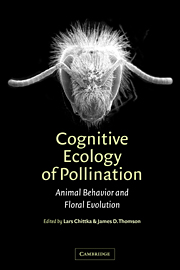Book contents
- Frontmatter
- Contents
- List of contributors
- Preface
- 1 The effect of variation among floral traits on the flower constancy of pollinators
- 2 Behavioral and neural mechanisms of learning and memory as determinants of flower constancy
- 3 Subjective evaluation and choice behavior by nectar-and pollen-collecting bees
- 4 Honeybee vision and floral displays:from detection to close-up recognition
- 5 Floral scent, olfaction, and scent-driven foraging behavior
- 6 Adaptation, constraint, and chance in the evolution of flower color and pollinator color vision
- 7 Foraging and spatial learning in hummingbirds
- 8 Bats as pollinators: foraging energetics and floral adaptations
- 9 Vision and learning in some neglected pollinators: beetles, flies, moths, and butterflies
- 10 Pollinator individuality: when does it matter?
- 11 Effects of predation risk on pollinators and plants
- 12 Pollinator preference, frequency dependence, and floral evolution
- 13 Pollinator-mediated assortative mating: causes and consequences
- 14 Behavioural responses of pollinators to variation in floral display size and their influences on the evolution of floral traits
- 15 The effects of floral design and display on pollinator economics and pollen dispersal
- 16 Pollinator behavior and plant speciation: looking beyond the “ethological isolation” paradigm
- Index
15 - The effects of floral design and display on pollinator economics and pollen dispersal
Published online by Cambridge University Press: 13 August 2009
- Frontmatter
- Contents
- List of contributors
- Preface
- 1 The effect of variation among floral traits on the flower constancy of pollinators
- 2 Behavioral and neural mechanisms of learning and memory as determinants of flower constancy
- 3 Subjective evaluation and choice behavior by nectar-and pollen-collecting bees
- 4 Honeybee vision and floral displays:from detection to close-up recognition
- 5 Floral scent, olfaction, and scent-driven foraging behavior
- 6 Adaptation, constraint, and chance in the evolution of flower color and pollinator color vision
- 7 Foraging and spatial learning in hummingbirds
- 8 Bats as pollinators: foraging energetics and floral adaptations
- 9 Vision and learning in some neglected pollinators: beetles, flies, moths, and butterflies
- 10 Pollinator individuality: when does it matter?
- 11 Effects of predation risk on pollinators and plants
- 12 Pollinator preference, frequency dependence, and floral evolution
- 13 Pollinator-mediated assortative mating: causes and consequences
- 14 Behavioural responses of pollinators to variation in floral display size and their influences on the evolution of floral traits
- 15 The effects of floral design and display on pollinator economics and pollen dispersal
- 16 Pollinator behavior and plant speciation: looking beyond the “ethological isolation” paradigm
- Index
Summary
Animal pollination is a mixed blessing for angiosperms. Animals carry pollen readily because they are mobile and large relative to pollen grains. Furthermore, animals learn to associate floral signals with the presence of food and so move between conspecific plants relatively consistently (Chittka et al., this volume; Gegear & Laverty, this volume; Giurfa, this volume; Menzel, this volume). However, animals act in their own interests, which often conflict with successful pollen transport (e.g., only about 1% of a plant's pollen production reaches stigmas; Harder 2000). Consequently, manipulation of pollinator behavior to promote cross-pollination is a prevailing theme in the evolution of floral design (form, color, nectar, and fragrance production) and display (inflorescence size and architecture).
This chapter reviews three aspects of pollinator manipulation by plants and their effects on pollen dispersal. First, because pollen dispersal for most animal-pollinated plants depends on the general responses of feeding pollinators to their foraging environment, we consider the underlying economic principles that establish the opportunities for floral manipulation. Second, we outline influences on the typical pattern of pollen dispersal among flowers for plants with granular pollen, and summarize how flower design affects this pattern (for a review of dispersal of orchid pollen, see Harder 2000). Finally, because pollination and mating success are characteristics of entire plants, rather than individual flowers, we consider how floral display affects pollinator attraction and within-plant behavior to determine pollen dispersal.
- Type
- Chapter
- Information
- Cognitive Ecology of PollinationAnimal Behaviour and Floral Evolution, pp. 297 - 317Publisher: Cambridge University PressPrint publication year: 2001
- 46
- Cited by



